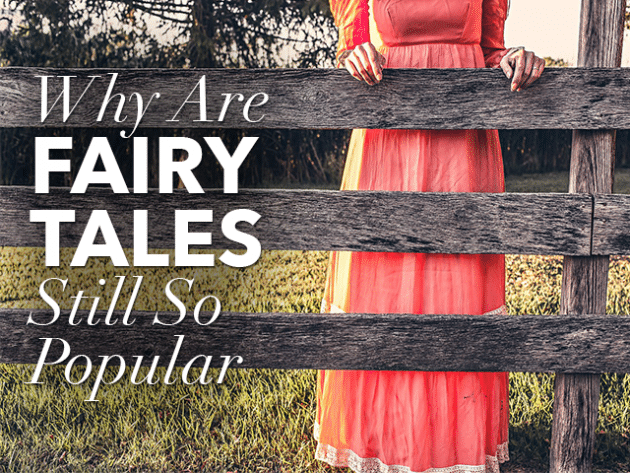Disney released its new live re-telling of its classic fairy tale Cinderella last week to mostly good reviews and high enthusiasm.

This, after we’ve already consumed almost the exact same story in cartoon form for years, read the fairy tale itself, and consumed countless remixes of it, from Ever After to Confessions of an Ugly Stepsister to Pretty Woman to Into the Woods to… you get the point.
And Cinderella is hardly the only tale with this power. Consider how many different ways stories like The Wizard of Oz, Snow White, Romeo and Juliet, even Batman have been reinvented over the years.
But why do readers do this? Why do some stories keep readers coming back again and again? How do fairy tales stay popular for so long?
Well, there are a few reasons fairy tales are so timeless.
Fairy tales are shared experience
An abused, lonely girl gets a lucky break to have one beautiful night of perfection, but stays too long and leaves a shoe behind in her rush get away before the spell is broken.
It’s a story almost all of us grew up with. The simple fact that we all share it makes it meaningful to adapt it.
These stories give us meaning to believe in
“Have courage and be kind.” That’s the message the new Cinderella movie repeats again and again.
Or what about Beauty and the Beast, and its faith in finding the beauty within?
And Superman is constantly fighting the good fight in the name of mankind’s innate goodness.
Then there’s Romeo and Juliet, Exhibit A for the kind of love that makes everything else fade away.
These messages may come off as simple platitudes sometimes, but people never want to stop believing.
We fill in the gaps with ourselves
Fairy tales break the key rules of characterization. For all their oddity and distinctiveness, the characters of fairy tales are often underdeveloped, if you look at their more traditional versions.
The same could be said of many of our most retold stories.
And therein lies the attraction—when a story gives us gaps, we fill them with ourselves. With so much to explore, there’s no end to the possibilities, and the results are deeply personal and compelling.
As our culture changes, we bring our stories with us
With every generation comes a fresh perspective, and a whole new set of experiences, values and ideas to be delve into.
With a whole cast of characters ripe for us to project onto, it’s easy to see how certain stories don’t get old no matter how many times they’re spun into something new.
So why does any of this matter?
Why does any of this matter for you, dear writer? Good question, glad you asked.
As writers, we bend over backwards to find totally original story no one has ever heard of before—but we’re too hard on ourselves. It’s not about absolute originality, it’s about the fresh take that is true to you.
Don’t be afraid to borrow from the greats—plenty of other greats are. Just add yourself.
What story keeps you coming back again and again? Let me know in the comments section.
PRACTICE
What story or fairy tale would you love to re-tell? What’s your unique spin on the story? Do a fifteen minute brainstorm to think through your story, and then share it in the comments.
By day, Emily Wenstrom, is the editor of short story website wordhaus, author social media coach, and freelance content marketing specialist. By early-early morning, she is E. J. Wenstrom, a sci-fi and fantasy author whose first novel Mud will release in March 2016.
Hi Emily! Good stories never get old — that’s the power of good storytelling. And it’s not just the actual story in it of itself — it’s the experience of reading it or it being read to you. Or remembering the first time you saw the film — and the story behind the film viewing.
In terms of Cinderella, when I think of this fairy tale, I think of my daughters asking me to draw them Cinderella pictures over and over and over again — because me reading the story to them moved them to want me to draw Cinderella for them!
I also think of what my daughters called “The Cinderella Store,” a video rental store just up the block from where my parents lived, where we always, always rented Cinderella.
And this goes along with what you were saying about fairy tales leaving gaps for us to fill in — in my case my memories of drawing countless Cinderellas with buns and pouffy dresses and visiting the “Cinderella store” when my girls and I went to visit my mom and dad.
My daughters didn’t grow up wanting to be rescued by a prince, but grew up with happy memories of the time we spent together reading, watching or drawing Cinderella!
Good stories should move us in some way — whether it be to draw characters from the stories or write our own stories. And that’s something that fairy tales got right — they stuck with a common human-theme that we can all relate to in some way, but that we can also take with a grain of salt and put our own spins to 🙂
What a fun blog! Thank you for the inspiration!
I just found this post thruogh Pinterest but had to comment how much I loved your modern take on Cinderella. Would be lovely to read the whole story… 😉
Thanks! I love the fairy tales. sesli masallar
Why after spending somuch money on her birth would her parent ignore her? I can’t read any further.